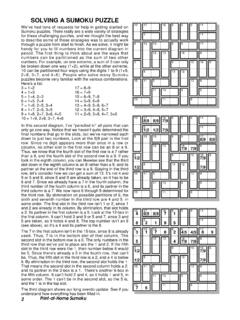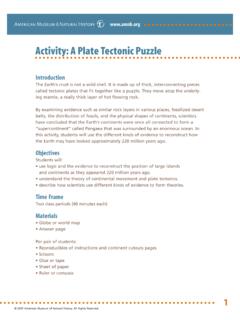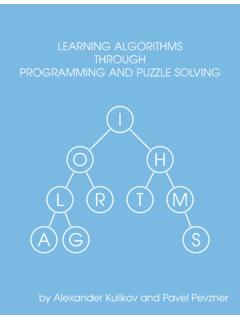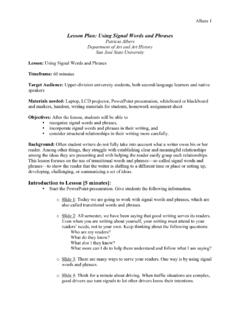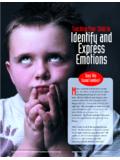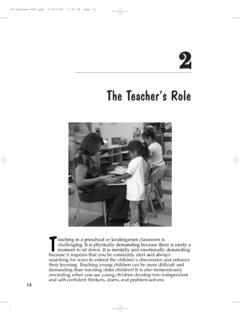Transcription of Capturing students’ attention: An empirical study - ed
1 Journal of the Scholarship of Teaching and Learning, Vol. 13, No. 5, December 2013, pp. 1 20. Capturing students attention: An empirical study Erik Rosegard1 & Jackson Wilson2 Abstract: College students (n=846) enrolled in a general education course were randomly assigned to either an arousal (experimental) or no-arousal (control) group. The experimental group was exposed to a topic-relevant, 90-second external stimulus (a technique used to elevate arousal and focus attention). The control group listened to the instructor take roll. Both groups then listened to the same 30-minute lecture followed by an exam. An independent-samples t-test found a significant difference in exam scores measuring information retention between arousal (M= , SD= ) and no-arousal (M= , SD= ) conditions; t (844)= , p <.
2 001. Results suggest introducing a lecture with an external stimulus increases information retention. Keywords: arousal, attention, memory, retention I. Introduction. Boredom is a significant issue in higher education (Craig, Graesser, Sullins, & Gholson, 2004; Pekrun, Goetz, Titz, & Perry, 2002; Shernoff & Csikszentmihalyi, 2003). In a series of five studies, Pekrun, Goetz, Daniels, Stupnisky, and Perry (2010) found a positive relationship between boredom and attentional problems while a negative relationship existed between boredom and academic performance. In a subsequent review, Pekrun, Goetz, Frenzel, Barchfeld, and Perry (2011) found that boredom was negatively related to motivation to learn, processing of information, and memory.
3 Wallace, Kass, and Stanny (2002) and Wallace, Vodanovich, and Restino (2003) found a strong association between boredom and cognitive-based mistakes ( , attention deficits and memory failures). These academic related issues may lead to lower GPAs (Maroldo, 1986) and higher dropout rates (Farmer & Sundberg, 1986). Boredom is also prevalent in higher education. Mann and Robinson (2009) found that of university students experience boredom with experiencing boredom most or all of the time. According to a 2010 Higher Education Research Institute (HERI) report, the weighted national norm for first-year students feeling bored in the classroom was (Pryor, Hurtado, DeAngelo, Blake, & Tran, 2010).
4 Pekrun et al. (2010) found boredom to be experienced significantly more than other negative emotions directly tied to learning and achievement ( , anxiety, anger, hopelessness). This academic emotion was one of the most cited reasons for dropping out of college (Farmer & Sundberg, 1986). Compared to other developed countries, the United States now has the highest college dropout rate in the industrialized world (Symonds, Schwartz, & Ferguson, 2011, p. 10). Evidence supports the need to address the deleterious effects of this significant and widespread academic emotion. However, boredom involves motivational, cognitive, and physiological factors that are difficult to define and measure (Farmer & Sundberg, 1986; Mikulas & Vodanovich, 1993; O Hanlon, 1981; Pekrun & Linnenbrink-Garcia, 2012).
5 In developing a comprehensive definition of boredom based on a systematic, cross-disciplinary review, Vogel- 1 Associate Professor, Department of Recreation, Parks, & Tourism, San Francisco State University, 2 Assistant Professor, Department of Recreation, Parks, & Tourism, San Francisco State University, Rosegard, E., & Wilson, J. Journal of the Scholarship of Teaching and Learning, Vol. 13, No. 5, December 2013. 2 Walcutt, Fiorella, Carper, and Schatz (2012) synthesized that boredom occurs when an individual experiences both the (objective) neurological state of low arousal and the (subjective) psychological state of dissatisfaction, frustration, or disinterest in response to the low arousal (p.)
6 102). This aversive state and associated suboptimal arousal can negatively affect the motivation to learn. One potential strategy to mitigate the negative effects of boredom is to increase arousal (Belton & Priyadharshini, 2007). A prevalent teaching strategy with prolific anecdotal evidence is the use of an external stimulus a hook, trigger, attention getter/grabber, or anticipatory set ( , Feden & Vogel, 2002; Hidi & Renninger, 2006; Hunter, 1994; McCarty & Siccone, 2001; Moore, 1987; White, 2007; Willis, 2006). These external stimuli capture students attention by touting the ability to increase arousal (decrease boredom), focus attention, and enhance learning and memory (Willis, 2006).
7 Although theoretically grounded in cognitive psychology and neuroscience, a paucity of empirical evidence exists on the efficacy of arousing techniques on attention and learning (Banas, Dunbar, Rodriguez, & Liu, 2011; Berk, 2011; Carlson, 2011). This is surprising given the widespread acceptance of attention getters used in the classroom and the recent contributions from brain-based learning a neuroscience moniker used to describe the comprehensive and interdisciplinary approach to teaching and learning based on the science of nervous system structures and functions (Caine & Caine, 2004). Buskist and Groccia (2011) commented, it is ironic that within higher education institutions dedicated to the discovery, transformation, and dissemination of knowledge, the choice of teaching strategies is based largely on experiential, commonsense, or anecdotal evidence (p.)
8 6). The following review of literature will provide an overview of arousal, attention, and memory. Although the three concepts are interdependent, arousal is often identified as the precursor to attention (Posner & Peterson, 1990). If there is sufficient arousal, attention to the stimulus allows cognitive processing of the stimulus resulting in the forming and storing of a memory (Wei, Wang, & Klausner, 2012). A. Arousal. The use of an external stimulus is intended to heighten arousal. Difficult to define and complex in function, arousal in its basic form is a multifaceted, interdependent construct that underlies all motivated behavioral responses, cognitive functions, and emotional expression (Pfaff, Ribeiro, Matthews, & Kow, 2008, p.
9 11). Although a comprehensive understanding of arousal has yet to be established and is beyond the scope of this paper, arousal is often considered the primary mechanism of the central and autonomic nervous system, and is considered both a physiological and psychological state based on sensory excitability (Berlyne 1960; Eysenck, 1982; Loewenstein, 1994). This neural excitation originates from sensory input received by the Reticular Activating System (RAS), which then sends the information to the limbic system for processing (see Lieberman, 2011, for a review of this process). Arousal is responsible for activating and regulating numerous mechanisms ( , attention and memory), and can range from sleep to a state of alertness (Eysenck, 1982; Robbins & Everitt, 1995).
10 As a construct, arousal has been used in numerous learning theories. The earliest, most notable is the Yerkes-Dodson Law (Yerkes & Dodson, 1908). Although the inverted U-shaped function between arousal and performance (learning) has been mislabeled, widely criticized, and viewed as simplistic and unidimensional (Baumler, 1994, as cited in Hancock & Ganey, 2003; Rosegard, E., & Wilson, J. Journal of the Scholarship of Teaching and Learning, Vol. 13, No. 5, December 2013. 3 Eysenck, 1982; Hanoch & Vitouch, 2004; Mandler, 1975), the basic premise of a curvilinear relationship has been replicated in studies with animals (Broadhurst, 1957) and humans (Dickman, 2002), with too much arousal leading to feelings of anxiety and too little arousal resulting in boredom (Apter, 1997; Belton & Priyadharshini, 2007; Csikszentmihalyi, 1975).










